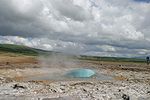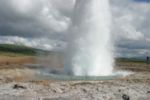Geyser

A geyser is a hot spring characterized by intermittent discharge of water ejected turbulently and accomplished by a vapor phase. The name geyser comes from Geysir, the name of an erupting spring at Haukadalur, Iceland; that name, in turn, comes from the Icelandic verb gjósa, “to gush”.
The formation of geysers requires a favourable hydrogeology which exists in only a few places on Earth, and so they are fairly rare phenomena. There must be a volcanic heat source. Generally all geyser field sites are located near active volcanic areas. The surface water works its way down to an average depth of around Template:Dist m ft where it meets up with the hot rocks. About 1,000 exist worldwide, with about half of these in Yellowstone National Park, U.S.[1] A geyser's eruptive activity may change or cease due to ongoing mineral deposition within the geyser plumbing, exchange of functions with nearby hot springs, earthquake influences, and human intervention.[2]
Erupting fountains of liquefied nitrogen have been observed on Neptune's moon Triton, as have possible signs of carbon dioxide eruptions from Mars' south polar ice cap. These phenomena are also often referred to as geysers. Instead of being driven by geothermal energy, they seem to rely on solar heating aided by a kind of solid-state greenhouse effect. On Triton, the nitrogen may erupt to heights of 8 kilometres (5 mi).
Formation and working
Geysers are temporary geological features. The life span of a geyser is, at the most, only a few thousand years. Geysers are generally associated with volcanic areas.[3] Geysers are caused when underground chambers of water are heated to the boiling point by the volcanic rock. When heat causes the water to boil, pressure forces a superheated column of steam and water to the surface. Their formation specifically requires the combination of 3 geologic conditions that are usually found in volcanic terrain.[3]
- Intense heat- The heat needed for geyser formation comes from magma when it is near the surface of the earth.The fact that they need heat much higher than normally found near the earth's surface is the reason they are associated with volcanoes or volcanic areas. Geysers, though rare, are found in the same geologic settings where volcanic heat sources are available.
- Water- The water a geyser ejects comes from snow and rain. When precipitation reaches the ground, most of it drains into rivers and streams. A small portion, perhaps 5% gets, soaked into the ground. Moving gradually through tiny cracks it finds its way into the underground tunnels that make up the plumbing of a geyser, then is shot to the surface during an eruption. Travel from the surface down through the rock and out through a geyser eruption can take up-to a time period of 500 years.[4]
- A plumbing system- In order for the heated water to form a geyser a plumbing system is required. This includes a reservoir to hold the water while it is being heated. Geysers are generally aligned along faults, the cracks in the earth formed by earthquakes.[3] The plumbing system is made up of a system of fractures, fissures, porous spaces and sometimes cavities. Constrictions in the system are essential to the building up of pressure before an eruption.
Ultimately, the temperatures near the bottom of the geyser rise to a point where boiling begins; steam bubbles rise to the top of the column. As they burst through the geyser's vent, some water overflows or splashes out, reducing the weight of the column and thus the pressure on the water underneath. With this release of pressure, the superheated water flashes into steam, boiling violently throughout the column. The resulting froth of expanding steam and hot water then sprays out of the geyser hole.[3]
Eruptions
Geyser activity, like all hot spring activity, is caused by surface water gradually seeping down through the ground until it meets rock heated by magma. The geothermally heated water then rises back toward the surface by convection through porous and fractured rocks. Geysers differ from non-eruptive hot springs in their subterranean structure; many consist of a small vent at the surface connected to one or more narrow tubes that lead to underground reservoirs of water.[4]
As the geyser fills, the water at the top of the column cools off, but because of the narrowness of the channel, convective cooling of the water in the reservoir is impossible. The cooler water above presses down on the hotter water beneath, not unlike the lid of a pressure cooker, allowing the water in the reservoir to become superheated, i.e. to remain liquid at temperatures well above the boiling point.[4]
The rocks in the nearby region produce a material called geyserite. Geyserite is mostly silicon dioxide (SiO2), is dissolved from the rocks and gets deposited on the walls of the geyser's plumbing system and on the surface. The deposits make the channels carrying the water up to the surface pressure-tight. This allows the pressure to be carried all the way to the top and not be leaked out into the loose gravel or soil that are normally under the geyser fields.[4]
Eventually the water remaining in the geyser cools back to below the boiling point and the eruption ends; heated groundwater begins seeping back into the reservoir, and the whole cycle begins again. The duration of eruptions and time between successive eruptions vary greatly from geyser to geyser; Strokkur in Iceland erupts for a few seconds every few minutes, while Grand Geyser in the U.S. erupts for up to 10 minutes every 8–12 hours.[4]
General categorization
There are two types of geysers: fountain geysers which erupt from pools of water, typically in a series of intense, even violent, bursts; and cone geysers which erupt from cones or mounds of siliceous sinter (also known as geyserite), usually in steady jets that last anywhere from a few seconds to several minutes. Old Faithful, perhaps the best-known geyser at Yellowstone National Park, is an example of a cone geyser. Grand Geyser, the tallest predictable geyser on earth, also at Yellowstone National Park, is an example of a fountain geyser.[5]
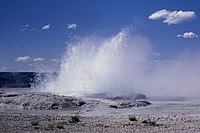
|

|
1. Fountain geyser (erupting from the pool)
|
2. Old Faithful geyser (cone geyser having mound of siliceous sinter) in Yellowstone National Park erupts approximately every 91 minutes
|
The intense transient forces inside erupting geysers are the main reason for their rarity. There are many volcanic areas in the world that have hot springs, mud pots and fumaroles, but very few with geysers. This is because in most places, even where other necessary conditions for geyser activity exist, the rock structure is loose, and eruptions will erode the channels and rapidly destroy any nascent geysers.[6]
Most geysers form in places where there is volcanic rhyolite rock which dissolves in hot water and forms mineral deposits called siliceous sinter, or geyserite, along the inside of the plumbing systems. Over time these deposits cement the rock together tightly, strengthening the channel walls and enabling the geyser to persist; as mentioned in the previous section.[6]
Geysers are fragile phenomena and if conditions change, they can ‘die’. Many geysers have been destroyed by people throwing litter and debris into them; others have ceased to erupt due to dewatering by geothermal power plants. The Great Geysir of Iceland has had periods of activity and dormancy. During its long dormant periods, eruptions were sometimes humanly-induced—often on special occasions—by the addition of surfactants to the water. Inducing eruptions at Geysir is no longer done, as the forced eruptions were damaging the geyser's special plumbing system. Following an earthquake in Iceland in 2000 the geyser became somewhat more active again. Initially the geyser erupted about eight times a day. As of July 2003, Geysir erupts several times a week.[6]
Biology of geysers
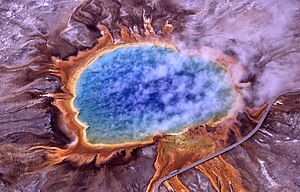
The specific colours of geysers derive from the fact that despite the apparently harsh conditions, life is often found in them (and also in other hot habitats) in the form of thermophilic prokaryotes. No known eukaryote can survive over 60 °C (140 °F).[7]
In the 1960s, when the research of biology of geysers first appeared, scientists were generally convinced that no life can survive above around 73 °C (163 °F)—the upper limit for the survival of cyanobacteria, as the structure of key cellular proteins and deoxyribonucleic acid (DNA) would be destroyed. The optimal temperature for thermophilic bacteria was placed even lower, around 55 °C (131 °F).[7]
However, the observations proved that it is actually possible for life to exist at high temperatures and that some bacteria prefer even temperatures higher than boiling point of water. Dozens of such bacteria are known nowadays.[8] Thermophiles prefer temperatures from 50 °C (122 °F) to 70 °C (158 °F) whilst hyperthermophiles grow better at temperatures as high as 80 °C (176 °F) to 110 °C (230 °F). As they have heat-stable enzymes that retain their activity even at high temperatures, they have been used as a source of thermostable tools, that are important in medicine and biotechnology[9], for example in manufacturing antibiotics, plastics, detergents (by the use of heat-stable enzymes lipases, pullulanases and proteases), and fermentation products (for example ethanol is produced). The fact that such bacteria exist also stretches our imagination about life on other celestial bodies, both inside and outside of solar system. Among these, the first discovered and the most important for biotechnology is Thermus aquaticus.[10]
Major geyser fields and their distribution
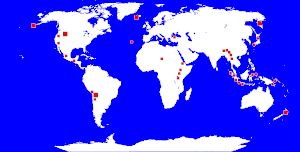
Geysers are quite rare, requiring a combination of water, heat, and fortuitous plumbing. The combination exists in few places on Earth.[11][12]
Yellowstone National Park
Yellowstone is the largest geyser locale, containing thousands of hot springs, and approximately 300 to 500 geysers. It is home to half of the world's total number of geysers in its nine geyser basins. It is located in Wyoming, United States.[13] Yellowstone includes the tallest active geyser (Steamboat Geyser in Norris Geyser Basin), as well as the renowned Old Faithful Geyser, Beehive Geyser, Giantess Geyser, Lion Geyser, Plume Geyser, Aurum Geyser, Castle Geyser, Sawmill Geyser, Grand Geyser, Oblong Geyser, Giant Geyser, Daisy Geyser, Grotto Geyser, Fan & Mortar Geysers, & Riverside Geyser, all in the Upper Geyser Basin which alone contains nearly 180 geysers.[12]
Dolina Geiserov
Dolina Geiserov is one of the geysers in the Valley of Geysers in the Kamchatka Peninsula of Russia. The area was discovered and explored by T.I. Ustinova in 1941. Approximately 200 geysers exist in the area along with many hot-water springs and perpetual spouters. The area was formed due to vigorous volcanic activity. The peculiar way of eruptions are an important feature of these geysers. Most of the geysers erupt at angles, and only very few have the geyser cones that exist at many other of the world's geyser fields.[12]
El Tatio
The name "El Tatio" roughly translates as "the grandfather". El Tatio is located in the high valleys on the Andes surrounded by many active Volcanoes in Chile, South America at around 4,200 meters above mean sea level. The valley is home to approximately 80 geysers at present. It became the largest geyser field in the Southern Hemisphere after the destruction of many of the New Zealand geysers. The salient feature of these geysers is that the height of their eruptions is very low, tallest being only six meters high. The average geyser eruption height at El Tatio is about Template:Dist m ft[12][14]
Taupo Volcanic Zone
The Taupo Volcanic Zone is located on the North Island in New Zealand. Many geysers in this zone were destroyed due to Geothermal developments and a hydroelectric reservoir, but several dozen geysers still exist. In the beginning of the twentieth century, the largest geyser ever known, the Waimangu Geyser existed in this zone. It began erupting in 1900 and erupted periodically for four years until a landslide changed the local water table. Eruptions of Waimangu would typically reach 160 meters and some superbursts are known to have reached Template:Dist m ft[12]
Iceland

Iceland is an island country off the western coast of Europe in the Atlantic Ocean. Geysers and hot springs are distributed all over the island. The geyser, or the local name geysir are located in Haukadalur. Geysers are known to have existed in at least a dozen other areas on the island. An earthquake in June, 2000 activated the dormant geyser which then erupted five times per week which may reach upto Template:Dist m ft.[12]
Extinct/Dormant geyser fields
There used to be two large geysers fields in Nevada—Beowawe and Steamboat Springs—but they were destroyed by the installation of nearby geothermal power plants. At the plants, geothermal drilling reduced the available heat and lowered the local water table to the point that geyser activity could no longer be sustained.[12]
Many of New Zealand’s geysers have been destroyed by humans in the last century. Several New Zealand geysers have also become dormant or extinct by natural means. The main remaining field is Whakarewarewa at Rotorua.[15] Two thirds of the geysers at Orakei Korako were flooded by the Ohakuri hydroelectric dam in 1961. The Wairakei field was lost to a geothermal power plant in 1958. The Taupo Spa field was lost when the Waikato River level was deliberately altered in the 1950s. The Rotomahana field was destroyed by the Mount Tarawera eruption in 1886.[16]
Misnamed geysers
There are various other types of geysers which are different in nature compared to the normal steam-driven geysers. These geysers not only differ in their style of eruption but also in the cause that makes them erupt. Such geysers are not true geysers but are yet referred as one as they all emit water under pressure.
- Artificial geysers
In a number of places where there is geothermal activity, wells have been drilled and fitted with impermeable casements that allow them to erupt like geysers. Even though the vents of such geysers are artificial, it is tapped into a natural hydrothermal system. Though these are so-called artificial geysers, technically known as erupting geothermal wells, are not true geysers. Little Old Faithful Geyser, in Calistoga, California, is probably an example of it. The geyser erupts from the casing of the a well drilled in the late 1800's. According to Dr. John Rinehart in his book A Guide to Geyser Gazing (1976 p.49), a man had drilled into the geyser in search for water. He had actually "simply opened up a dead geyser".[17]
- Cold-water geysers
Cold-water geysers' eruption is similar to their hot water counterparts, except that CO2 bubbles drive the eruption instead of steam. In cold-water geysers, CO2-laden water lies in a confined aquifer, in which water and CO2 are trapped by less permeable overlying strata. This water and CO2 can escape this strata only weak regions like faults, joints, or drilled wells. A drilled borehole provides an escape for the pressurized water and CO2 to reach the surface. The magnitude and frequency of such eruptions depend on various factors such as plumbing depth, CO2 concentrations, aquifer yield etc. The column of water exerts enough pressure on the gaseous CO2 so that it remains in the water in small bubbles. When the pressure decreases due to formation of a fissure, the CO2 bubbles expand. This expansion dispaces the water and causes the eruption.The appearance of cold-water geysers may be quite similar to their steam-driven counterparts; however, often CO2-laden water is more white and frothy.[18] The best known of these is probably Crystal Geyser, near Green River, Utah.[19]. There are also two cold-water geysers in Germany: Brubbel and Geysir Andernach.
A perpetual spouter is a natural hot spring that spouts water constantly without stopping for recharge. Some of these are incorrectly called geysers, but because they are not periodic in nature they are not considered true geysers.[20]
Commercial uses of geysers

Geysers are used for various activities such as electricity generation, heating and tourism. Many geothermal reserves are found all around the world. Geysers in Iceland are one of the most commercially viable geyser location in the world. Since 1920's hot water directed from the geysers have been used to heat greenhouses and used to grow food that could not have been cultivated in Iceland's inhospitable climate.[21] Steam and hot water from the geysers has also been used for heating homes since 1943 in Iceland. In 1979 the U.S. Department of Energy (DOE) actively promoted development of geothermal energy in the Geysers-Calistoga Known Geothermal Resource Area (KGRA) through a variety of research programs and the Geothermal Loan Guarantee Program and was thus obligated by law to assess its potential environmental impacts.[22]
Nitrogen geysers on Triton
One of the great surprises of the Voyager 2 flyby of Neptune in 1989 was the discovery of geysers on its moon, Triton. Astronomers noticed dark plumes rising to some 8 km above the surface,and depositing material up to 150 km downstream.,[23]
All the geysers observed were located between 50° and 57°S, the part of Triton's surface close to the subsolar point. This indicates that solar heating, although very weak at Triton's great distance from the Sun, probably plays a crucial role. It is thought that the surface of Triton probably consists of a semi-transparent layer of frozen nitrogen white in colour, which creates a kind of greenhouse effect, heating the frozen material beneath it until it breaks the surface in an eruption. A temperature increase of just 4 K above the ambient surface temperature of 37 K could drive eruptions to the heights observed. But more likely these eruptions are caused by tidal forces.[24]
Geothermal energy may also be important. Unusually for a major satellite, Triton orbits Neptune in a retrograde orbit—that is, in the opposite direction to Neptune's rotation. This generates tidal forces which are causing Triton's orbit to decay, so that in several billion years time it will reach its Roche limit[25] with Neptune. The tidal forces may also generate heat inside Triton, in the same way as Jupiter's gravity generates tidal forces on Io which drive its extreme volcanic activity.[24]
Each eruption of a Triton geyser may last up to a year, and during this time about 0.1 cukm[convert: unknown unit] of material may be deposited downwind. Voyager's images of Triton's southern hemisphere show many streaks of dark material laid down by geyser activity.[24]
Notes
- ^ Glennon, J.A. 2007
- ^ Bryan, T.S. 1995
- ^ a b c d How geysers form Gregory L. Jones; wyojones.com Retrieved on 2008-04-05
- ^ a b c d e Lee Krystek Weird Geology: Geysers unmuseum.org Retrieved on 2008-03-28
- ^ Yellowstone thermal features Yahoo! Inc. Retrieved on 2008-04-02
- ^ a b c Plumbing system Advameg Inc. Retrieved on 2008-04-02
- ^ a b Lethe E. Morrison, Fred W. Tanner; Studies on Thermophilic Bacteria Botanical Gazette, Vol. 77, No. 2 (Apr., 1924), pp. 171-185
- ^ Michael T. Madigan and Barry L. Marrs; Extremophiles atropos.as.arizona.edu Retrieved on 2008-04-01
- ^ Vielle, C.; Zeikus, G.J. Hyperthermophilic Enzymes: Sources, Uses, and Molecular Mechanisms for Thermostability. Microbiology and Molecular Biology Reviews. 2001, 65(1), 1-34.
- ^ Industrial Uses of Thermophilic Cellulase University of Delaware, Retrieved on 2008-03-29
- ^ Glennon, J.A. and Pfaff R.M. 2003; Bryan 1995
- ^ a b c d e f g Glennon, J Allan"World Geyser Fields" Retrieved on 2008-04-04
- ^ "Yellowstone geysers" nps.gov Retrieved on 2008-03-20
- ^ Glennon, J.A. and Pfaff. R.M., 2003)
- ^ "Whakarewarewa, The Thermal Village" Retrieved 2008-04-04
- ^ "Geysers Water Hot Geothermal Field Places Activity." Retrieved 2008-04-04
- ^ Jones, Wyoming "Old Faithful Geyser of California" WyoJones' Geyser Pages Retrieved on 2008-03-31
- ^ Glennon, J. Alan"Carbon-Dioxide-Driven, Cold-Water Geysers" Retrieved on 2008-04-01
- ^ Glennon, J.A. 2005; Glennon, J.A. and Pfaff, R.M. 2005
- ^ WyoJones"Thermal Feature Definitions" WyoJones Retrieved on 2008-04-03
- ^ Geysers and Energy american.edu Retrieved on- April 2008
- ^ Kerry O’Banion and Charles Hall Geothermal energy and the land resource: conflicts and constraints in The Geysers- Calistoga KGRA osti.gov Retrieved on- April 2008
- ^ "Triton (Voyager)". NASA (Voyager The Interstellar Mission). June 1, 2005. Retrieved 2008-04-03.
{{cite web}}: Check date values in:|date=(help) - ^ a b c Kirk, R.L., Branch of Astrogeology"Thermal Models of Insolation-driven Nitrogen Geysers on Triton" Harvard Retrieved 2008-04-08
- ^ "Roche Limit"Harvard Retrieved 2008-04-08
References
- Bryan, T. Scott (1995). The geysers of Yellowstone. Niwot, Colorado: University Press of Colorado. ISBN 0-87081-365-X
- Glennon, J.A., Pfaff, R.M. (2003). The extraordinary thermal activity of El Tatio Geyser Field, Antofagasta Region, Chile, Geyser Observation and Study Association (GOSA) Transactions, vol 8. pp. 31-78.
- Glennon, J.A. (2005). Carbon Dioxide-Driven, Cold Water Geysers, University of California, Santa Barbara. Originally posted February 12, 2004, last update 6 May 2005. Accessed 8 June 2007.
- Glennon, J.A. (2007). About Geysers, University of California, Santa Barbara. Originally posted January 1995, updated June 4, 2007. Accessed 8 June 2007.
- Glennon, J.A., Pfaff, R.M. (2005). The operation and geography of carbon-dioxide-driven, cold-water geysers, GOSA Transactions, vol. 9, pp. 184-192.
- Kelly W.D., Wood C.L. (1993). Tidal interaction: A possible explanation for geysers and other fluid phenomena in the Neptune-Triton system, in Lunar and Planetary Inst., Twenty-Fourth Lunar and Planetary Science Conference. Part 2: 789-790.
- Rinehart, J.S. (1980) Geysers and Geothermal Energy. Springer-Verlag, 223 p.
- Schreier, Carl (2003). Yellowstone's geysers, hot springs and fumaroles (Field guide) (2nd ed.). Homestead Pub. ISBN 0-943972-09-4
- Soderblom L.A., Becker T.L., Kieffer S.W., Brown R.H., Hansen C.J., Johnson T.V. (1990). Triton's geyser-like plumes — Discovery and basic characterization. Science 250: 410-415.
- Allen, E.T. and Day, A.L. (1935) Hot Springs of the Yellowstone National Park, Publ. 466. Carnegie Institute of Washington, Washington, D.C., 525 p.
- Barth, T.F.W. (1950) Volcanic Geology: Hot Springs and Geysers of Iceland, Publ. 587. Carnegie Institute of Washington, Washington, D.C., 174 p.
- Rhinehart, J.S. (1972) Fluctuations in geyser activity caused by variations in earth tidal forces, barometric pressure, and tectonic stresses. Jour. Geophys. Res. 77, 342-350.
- Rhinehart, J.S. (1972) 18.6-year tide regulates geyser activity. Science 177, 346-347.
- Rhinehart, J.S. (1980) Geysers and Geothermal Energy. Springer-Verlag, 223 p.
- Silver, Paul G. and Valette-Silver, Nathalie J. (1992) Detection of Hydrothermal Precursors to Large Northern California Earthquakes. Science 257, 1363-1368.
- White, D.E. (1967) Some principles of geyser activity mainly from Steamboat Springs, Nevada. Amer. Jour. Sci. 265, 641-684.
- M.K. Bhat. Cellulases and related enzymes in biotechnology. Biotechnology Advances. 2000, 18, 355-383.
- Haki, G.D.; Rakshit, S.K. Developments in industrially important thermostable enzymes: a review. Bioresource Review. 2003, 89, 17-34.
- Vielle, C.; Zeikus, G.J. Hyperthermophilic Enzymes: Sources, Uses, and Molecular Mechanisms for Thermostability. Microbiology and Molecular Biology Reviews. 2001, 65(1), 1-34.
- Schiraldi, C.; De Rosa,M. The production of biocatalysts and biomolecules from extremophiles. Trends in Biotechnology. 2002, 20(12), 515-521.
- Hreggvidsson, G.O.; Kaiste, E.; Holst, O.; Eggertsson, G.; Palsdottier, A.; Kristjansson, J.K. An Extremely Thermostable Cellulase from the Thermophilic Eubacterium Rhodothermus marinus. Applied and Environmental Microbiology. 1996, 62(8), 3047-3049.
- Crennell, S.J.; Hreggvidsson, G.O.; Karisson, E.N. The Structure of Rhodothermus marinus Cel12A, A Highly Thermostable Family 12 Endoglucanase, at 1.8Å Resolution. J. Mol. Biol. 2002, 320, 883-897.
- Hirvonen, M.; Papageorgiou, A.C. Crystal Structure of a Family 45 Endoglucanases from Melanocarpus albomyces: Mechanist Implications Based on the Free and Cellobiose-bound Forms. J. Mol. Biol. 2003, 329, 403-410.
- Iogen doubles EcoEthanol Capacity. April 28, 2003. (accessed May 17, 2003).
- Pelach, M.A.; Pastor, F.J.; Puig, J.; Vilaseca, F.; Mutje, P. Enzymic deinking of old newspapers with cellulase. Process Biochemistry. 2003, 38, 1063-1067.
- Dienes, D.; Egyhazi, A.; Reczey, K. Treatment of recycled fiber with Trichoderma cellulases. Industrial Crops and Products. 2004, article in press.
- Csiszar, E.; Losonczi, A. Szakacs, G. Rusznak, I.; Bezur, L.; Reicher, J. Enzymes and chelating agent in cotton pretreatment. Journal of Biotechnology. 2001, 89, 271-279.
- Ryback and L.J.P. Muffler, ed., Geothermal Systems: Principles and Case Histories (New York: John Wiley & Sons, 1981), 26.
- Harsh K. Gupta, Geothermal Resources: An Energy Alternative (Amsterdam: Elsevier Scientific Publishing, 1980), 186.
- The Earth Explored: Geothermal Energy, 19857 videocassette.
- Brimner, Larry Dane. Geysers. New York: Children's Press, 2000.
- Downs, Sandra. Earth's Fiery Fury. Brookfield, CT: Twenty-First Century Books, 2000.
- Gallant, Roy A. Geysers: When Earth Roars. New York: Scholastic Library Publishing, 1997.
External links
- Geysers and How They Work by Yellowstone National Park
- Geyser Observation and Study Association (GOSA)
- Geysers of Yellowstone: Online Videos and Descriptions
- About Geysers by Alan Glennon
- Cold Water Geysers by Alan Glennon
- Geysers, The UnMuseum
- Johnston's Archive Geyser Resources
- The Geology of the Icelandic geysers by Dr. Helgi Torfason, geologist
- Geysers and the Earth's Plumbing Systems by Meg Streepey


